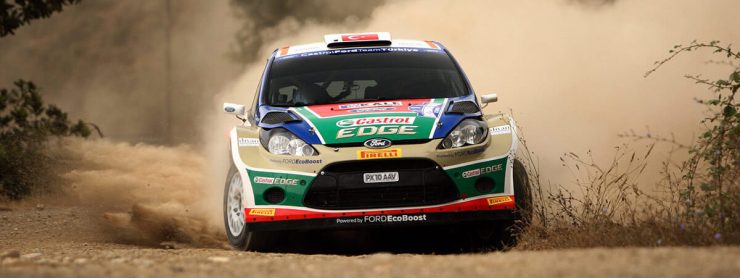1- WHAT IS RALLY?
The origins of modern day rallying coincide with the invention of the motor car.
Humankind has always had a competitive spirit. It was inevitable that as soon as the possibility of moving from A to B on four wheels arose, one person would want to do it faster than the others! That’s what world rallying is; moving from one place to another faster than any other person – in the world.
In the “old days” little regard was taken of where such movement occurred. Many of the original “rallies” were more “road races” such as the famous London to Brighton Rally, where cars were timed over the entire distance and the winner was the competitor with the fastest time.
Things have progressed somewhat and rallies now have a tightly controlled format with specific sections (called “special stages”) being reserved for competition, connected together by road or liaison sections.
Preparations for the hard-fought European Rally Championship begin many months before the first rally of the season. The governing body, the Federation Internationale de l’Automobile (FIA) approves routes, stages and final locations of the 11 rallies around Europe, and passes on a copy of the proposals to the major teams.
Each rally must allow one or two days for the reconnaissance (“recce”), one day for “Shakedown” (final testing of cars) and Media Conference and two or three days for competition. The rally typically has between 15 and 25 special stages. The competing crews are seeded and start the event according to their ranking, with the leader of the drivers’ championship setting off first.
Often there are up to 80 or 90 cars taking part in a rally.
The Recce
Driver and co-driver familiarise themselves with the various stages before the start of the event. They drive each special stage twice in a standard road-car (fitted with extra safety equipment) in the two days preceding the rally. It is here that the co-driver writes detailed pace notes for use on the special stages during competition.
The Stages
The special stages are the competitive sections of the rally – where the drivers and co-driver drive as fast as possible to achieve the quickest time. They take place on private roads or public roads, which are closed to the general public while the rally is in progress. A typical rally will have about 15 to 25 special stages over two or three days. The stages are linked by public roads – called road sections -on which competitors must obey all local traffic laws. Each day contains about 250km of driving – a third of which are the competitive special stages. Stages vary in length from five to 60kms, with the cars’ times being recorded after each stage to the tenth of a second. Over the entire event, the special stage distance must more than 250 km.
The Clock
Forget about ‘first across the line’. Rally cars don’t race directly against each other. They compete against the toughest opponent of all; time. Cars start at one or two minute intervals, racing against the clock, their times monitored and entered into the results system. Unless they run into trouble, rivals rarely see each other during a stage.
The Time Controls
A rally itinerary is governed by a strict timetable. Drivers get time penalties for being late (or early!) to clock in to the start of the special stage and at the entry and exit of service parks. Late arrival at these controls is typically penalised with 10 seconds on every minute over and is added to the overall time of the driver. Drivers can be excluded from a rally if they are 30 minutes late for a time control, 30 minutes late for a leg or 60 minutes for an entire rally.
How is a winner determined?
Each driver is given a starting signal on a set minute, the signal consisting of an electronic countdown involving a series of lights. When the start signal is given, the driver takes off from the start of the special stage and proceeds to drive as quickly as possible to the finish of the stage where, as the car passes the “Flying Finish” at full speed, its finish time is recorded as a time of day (in hours, minutes, seconds and tenths of a second). The driver’s time on the stage is then calculated and expressed in minutes, seconds and tenths of a second.
As each stage is conducted, the driver’s times are accumulated and the winner is the driver at the end of the event with the lowest total time. On the liaison sections (on public roads) crews are given a set amount of time in which to travel these sections, obeying all the speed limits. If the crew is late on one of these sections, because of a mechanical problem or similar, they are penalised at the rate of 10 seconds per minute late. This penalty is added to their total time for the rally and is called a “Road Penalty”. Crews who exceed the posted legal speed limits on the liaison sections not only face the usual civil penalties – the FIA has much harsher penalties which it does not hesitate to impose, and which can involve substantial fines (much larger than civil fines), time penalties and even exclusion from the event. At the end of an event, the driver who has taken the least amount of time (including any road penalties) to complete all the stages is the winner.
The Points
Results achieved during each of the 11 rallies count towards FIA European Rally Championship. The points system for the drivers works as follows:
1st 25 points
2nd 18 points
3rd 15 points
4th 12 points
5th 10 points
6th 8 points
7th 6 points
8th 4 points
9th 2 points
10th 1 point
2- THE CREW
Pivotal to success in the WRC is the partnership between driver and the co-driver, who work as a team to bring the car home safely in the fastest time. If the accelerator isn’t flat to the floor, a driver’s going too slow. If the brake isn’t flat to the floor, he’s going to crash. It’s not easy sitting behind the wheel of a rally car.
Just having a rally car will not make you a rally driver. Nor will flat-out, foot to the floor driving win you any titles. A top-class rally driver must be instinctive, brave, technically and tactically skilful (and a little bit mad). He must be passionate, precise, concentrated and have unflinching trust in his co-driver. And, he’s got to be quick too. The trust between driver and co-driver has to be absolute. Would you drive over a blind brow at 150kph in the fog, because your partner next to you said it was safe?
It’s the co-driver’s job to ‘guide’ the driver through the course. During the pre-rally recce, he (or she) writes extensive hand-written ‘pace notes’ on every corner, road surface, pothole, rock and potential hazard, so he can predict the speeds at which his driver can take the course the next day. He then reads them out to his driver as they hurtle through the stage. The co-drivers are the unsung heroes of the rallying. More usually it is the driver that hits the headlines, while the co-driver is back at the service park going over his ‘pace notes’ for the next day’s rallying. But he must be just as alert, committed and dedicated as his driver – without a good pace note reader, a driver is severely hindered.
3- SERVICE PARKS
After each group of stages is completed, the cars can visit a designated service park where repairs may be carried out by the teams under strict supervision at pre-determined times during each event. Besides interrogating data from the on-board data systems, changing tyres and making running adjustments, during this time a team of six technicians is allowed to perform mechanical work on each car. The time available is strictly limited, with each stop being either 10, 30 or 45 minutes depending on the itinerary.
At the end of each day the crews are allowed a longer 45-minute period to work on the cars before they are locked away in the guarded ‘parc fermé’ until the following morning’s restart. Crews are punished with time penalties for exceeding these alloted times.
After a gruelling stage, there’s no telling in what condition a car will come back to the service park. The crews, forewarned by radio just minutes before a car might limp home, wait to patch up the injured machine. They have just 20 minutes to make the car rally-worthy again.
As soon as the car enters the team enclosure, the clock starts ticking. Every second over the allotted time could land the team with a time penalty, potentially undoing all the time gained on a fast super stage.
Crews need to be quick, efficient, dextrous and calm under pressure.
Normally, cars are raised on four slim triangular stands and attended to by about 12 technicians, each specialists in their field. If the car comes in relatively unscathed, a routine stop would include a complete change of wheels and tyres, a fluid top-up and a ‘spanner’ check, which ensures every nut and bolt is tight and not loosened by the engine vibration.
The shock absorber, damper and ride-height settings may be adjusted and all four brake discs checked for wear and tear. Last but not least, the windshield is thoroughly cleaned. If, however, the car has struggled in, its bodywork battered, the windshield shattered, the bonnet crumpled and the suspension shot, the technicians have a more serious problem on their hands. Ingenious solutions have to be made up on the spot to ensure the car makes it around the next stage.
The choreographed blur of tool-wielding hands is an impressive sight in and under a rally car and the 20 minutes elapse all too quickly for the frantic technicians. They work under the beady eye of their crew-chief, who monitors their progress, oversees trouble-spots and constantly watches the clock, counting the minutes down in a loud and clear voice.




























